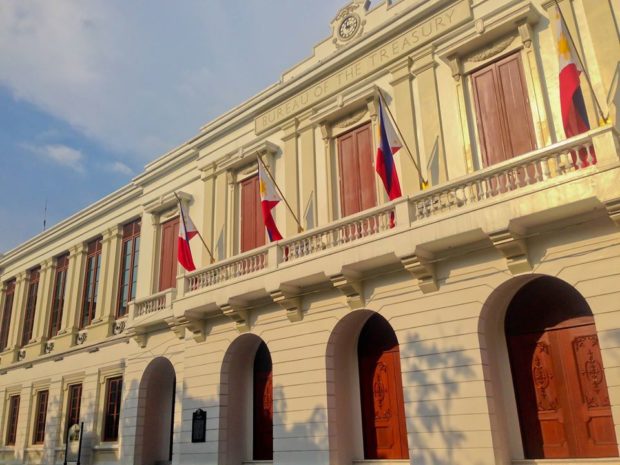
The Ayuntamiento de Manila which houses the Treasury Office (Taken from the office’s Facebook account)
MANILA, Philippines — As Philippine debt as a share of the economy hit a 16-year high last year, taking all the metrics into account would show that the nation’s growing government bonds have remained “sustainable.” , said an official from the Office of the Treasury (BTr). Wednesday (March 2).
Citing the BTr’s analysis and assessment of the Philippines’ debt to 2020, the head of its risk management division, Armin Paul Allado, said that “there is room for the country to absorbs more debt given the optimistic outlook for economic recovery and growth.” The government is aiming for gross domestic product (GDP) growth of 7-9% this year and then 6-7% per year in 2023 and 2024 to overcome the huge indebtedness resulting from massive borrowing to finance the protracted fight against the COVID-19.
In 2021, outstanding national government debt as a percentage of GDP soared to 60.5% – the highest since 2005. As the debt ratio rose above the 60% threshold deemed manageable among emerging markets as In the Philippines, President Rodrigo Duterte’s economic team will launch a fiscal consolidation plan for the next president to pay off his debts.
The fiscal consolidation strategy to reduce the fiscal gap – while paying down obligations – would likely consist of new or higher taxes, spending cuts in non-priority sectors, as well as economic growth engines to stimulate higher income.
Speaking at a conference of the Asian Development Bank Institute (ADBI), Allado said that in terms of debt quality, recent data reflected sustainability, pointing to the declining share of foreign bonds in the total outstanding amount, as well as the weighted average interest rate (WEIR) recovered by public borrowings.
For example, the latest BTr data showed that the share of external debt in the total at the end of 2021 fell further to 30.3% – the lowest in history – from 31.7% in 2020. The government is borrowing most of its needs locally through the issuance of Treasury bills and bonds, with the aim of mitigating exchange rate risks while taking advantage of the depletion of domestic liquidity.
Allado also noted that the WEIR for Philippine borrowings fell further to a low of 4.2% in 2020 from 5% in 2019, before the pandemic. The Philippines’ prime credit ratings allow it to borrow cheaper.
Furthermore, Allado said it was not just the overall debt-to-GDP ratio that determined sustainability – other indicators included the combination of outstanding domestic and foreign debt and financing; interest payments as a percentage of GDP, expenditure and revenue; as well as the annual GDP growth rate and the budget deficit ratio.
After assigning corresponding weights to these debt measures, the BTr’s calculations for what it called an annual public debt valuation index showed that in 2020 the debt-to-GDP ratio of 54.6 % – a jump from a record high of 39.6% in 2019 – remained below the sustainable debt ceiling of 59.97% for the Philippine economy.
“There is still room for debt level adjustments given the value of fiscal policy flexibility of 5.37%” in 2020, Allado said. The graph presented by Allado nevertheless showed that the gap between the actual debt ratio and the debt ceiling, which reflected fiscal flexibility, was the narrowest in recent years as the government increased borrowing to meet the COVID-19.
Until 2026, BTr calculations showed that projected debt-to-GDP ratios would remain below the debt ceilings of the economy. For example, last year’s debt ratio was below the estimated ceiling of 88.3% as the economy returned to growth after the worst post-war recession in 2020.
For this year, the projected debt-to-GDP ratio of 60.4% will be below the ceiling of 74.4%. In 2023, the debt ratio of 60.5% would be lower than the ceiling of 78.4%; in 2024, the debt-to-GDP ratio of 59.7% will be below the ceiling of 79%; in 2025, the ratio of 57.3% will be below the ceiling of 84% and in 2026, the debt ratio of 55.8% will be below the debt ceiling of 75.3%, according to BTr estimates .
Allado said the findings of the BTr study showed that “the Philippines’ current and projected debt levels are still sustainable, leaving some policy flexibility to absorb debt in the event of further adverse shocks.”
The government will borrow 2.2 trillion pesos this year, three-quarters of which was to come from the domestic debt market.
Borrowing this year will further increase outstanding debt to 13.42 trillion pesos by the end of the year, from 11.73 trillion pesos in 2021.
TSB
Read more
Subscribe to INQUIRER PLUS to access The Philippine Daily Inquirer and over 70 titles, share up to 5 gadgets, listen to the news, download as early as 4am and share articles on social media. Call 896 6000.



